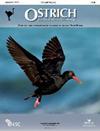Local variations in the response of birds to human presence in urban areas
IF 1.1
4区 生物学
Q2 ORNITHOLOGY
引用次数: 2
Abstract
Studies that seek to understand the local variations in the response of birds to human disturbance in urban areas are important for conservation. This article investigated the contribution of human population density in the different urban land use zones of Harare (high, medium and low-density residential areas, as well as industrial areas), among other variables, to the models explaining the flight initiation distance (FID) of twenty-five urban bird species. The specific objectives of the study were: to test whether the variables significantly predict FID; to investigate their relative contribution to the ‘best-performing’ models; and to determine the relationship between FID and the individual predictor variables. Generalised linear models were used to predict FID as a function of: flock size, intruder starting distance, urban land use zone, perch height, average bird mass and species. We predicted that FID would increase in tandem with flock size and average bird mass, and decrease inversely proportional to population density, intruder starting distance and perch height. We also expected FID to differ by species. Results illustrated that twelve models best explained the FID of birds in the study area. Urban land use zone, intruder starting distance and species were the only predictors that appeared in all the twelve models. However, flock size and average bird mass appeared in only six of the twelve models making them the least important predictor variables. These findings add to current knowledge on local variation in the FID of certain bird species within the different land use zones. The results could be used to create buffers aimed to minimise human-induced disturbance on bird species.城市地区鸟类对人类活动反应的局部变化
寻求了解城市地区鸟类对人类干扰反应的局部变化的研究对保护很重要。本文调查了哈拉雷不同城市土地利用区(高、中、低密度住宅区以及工业区)的人口密度以及其他变量对解释25种城市鸟类飞行起始距离(FID)的模型的贡献。该研究的具体目标是:测试变量是否能显著预测FID;调查他们对“最佳表现”模型的相对贡献;以及确定FID和各个预测变量之间的关系。使用广义线性模型预测FID,将其作为鸟群大小、入侵者起始距离、城市土地利用区、栖息高度、平均鸟类数量和物种的函数。我们预测,FID将随着鸟群大小和平均鸟量的增加而增加,并与种群密度、入侵者起始距离和栖息高度成反比。我们还预计FID会因物种而异。结果表明,12个模型最能解释研究区域内鸟类的FID。城市土地利用区、入侵者起始距离和物种是所有12个模型中出现的唯一预测因素。然而,在12个模型中,只有6个模型出现了鸟群大小和平均鸟量,这使它们成为最不重要的预测变量。这些发现增加了目前关于不同土地利用区内某些鸟类FID局部变化的知识。研究结果可用于创建缓冲区,以最大限度地减少人类对鸟类的干扰。
本文章由计算机程序翻译,如有差异,请以英文原文为准。
求助全文
约1分钟内获得全文
求助全文
来源期刊

Ostrich
生物-鸟类学
CiteScore
2.10
自引率
30.00%
发文量
24
审稿时长
>12 weeks
期刊介绍:
Ostrich: Journal of African Ornithology is the leading ornithological journal in Africa, and publishes peer-reviewed scientific papers and short communications (
 求助内容:
求助内容: 应助结果提醒方式:
应助结果提醒方式:


